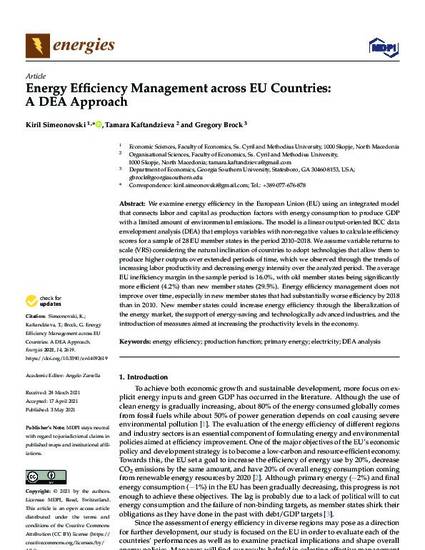
Article
Energy Efficiency Management across EU Countries: A DEA Approach
Energies
(2021)
Abstract
We examine energy efficiency in the European Union (EU) using an integrated model
that connects labor and capital as production factors with energy consumption to produce GDP
with a limited amount of environmental emissions. The model is a linear output-oriented BCC data
envelopment analysis (DEA) that employs variables with non-negative values to calculate efficiency
scores for a sample of 28 EU member states in the period 2010–2018. We assume variable returns to
scale (VRS) considering the natural inclination of countries to adopt technologies that allow them to
produce higher outputs over extended periods of time, which we observed through the trends of
increasing labor productivity and decreasing energy intensity over the analyzed period. The average
EU inefficiency margin in the sample period is 16.0%, with old member states being significantly
more efficient (4.2%) than new member states (29.5%). Energy efficiency management does not
improve over time, especially in new member states that had substantially worse efficiency by 2018
than in 2010. New member states could increase energy efficiency through the liberalization of
the energy market, the support of energy-saving and technologically advanced industries, and the
introduction of measures aimed at increasing the productivity levels in the economy.
Keywords
- energy efficiency,
- production function,
- primary energy,
- DEA analysis
Disciplines
Publication Date
Spring May 3, 2021
DOI
https://doi.org/10.3390/en14092619
Citation Information
Kiril Simeonovski, Tamara Kaftandzieva and Gregory J. Brock. "Energy Efficiency Management across EU Countries: A DEA Approach" Energies Vol. 14 Iss. 9 (2021) ISSN: 1996-1073 Available at: http://works.bepress.com/gregory_brock/197/
